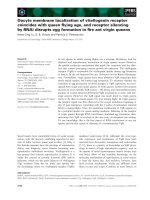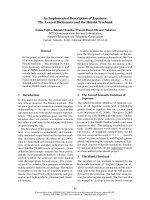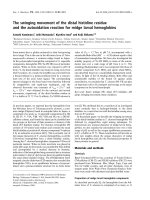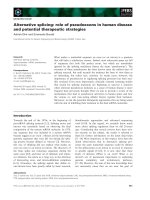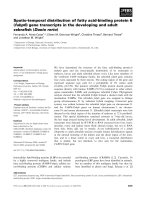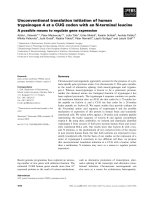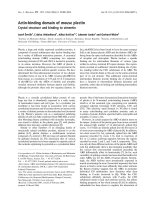báo cáo khoa học: "ShRNA-mediated gene silencing of MTA1 influenced on protein expression of ER alpha, MMP-9, CyclinD1 and invasiveness, proliferation in breast cancer cell lines MDA-MB-231 and MCF-7 in vitro" pptx
Bạn đang xem bản rút gọn của tài liệu. Xem và tải ngay bản đầy đủ của tài liệu tại đây (856.87 KB, 11 trang )
RESEARC H Open Access
ShRNA-mediated gene silencing of MTA1 influenced
on protein expression of ER alpha, MMP-9, CyclinD1
and invasiveness, proliferation in breast cancer cell
lines MDA-MB-231 and MCF-7 in vitro
Qingming Jiang
†
, Hui Zhang
*
and Ping Zhang
†
Abstract
Background: MTA1(metastasis associated-1) is a tumor metastasis associated candidate gene and overexpression
in many human tumors, including breast cancer. In this study, we investigated depressive effect on MTA1 by
MTA1-specific short hairpin RNA(shRNA) expression plasmids in human breast cancer cell lines MDA-MB-231 and
MCF-7, and effect on protein levels of ER alph a, MMP-9, cyclinD1, and tumor cell invasion, proliferation.
Methods: ShRNA expression vectors targeting MTA1 was constructed and transfected into human breast cancer
cell lines MDA-MB-231 and MCF-7. The transfection efficiency was evaluated by fluorescence microscopy, mRNA
levels of MTA1 were detected by reverse transcription-polymerase chain reaction (RT-PCR), protein levels of ER
alpha, MMP-9 and cyclinD1 were detected by Western blotting, respectively. Tumor cells invasive ability were
evaluated by Boyden chamber assay, the cells proliferation were evaluated using cell growth curve and MTT
analysis, the cell cycle analysis was performed using flow cytometry.
Results: Down-regulation of MTA1 by RNAi approach led to re-expression of ER alpha in ER-negative breast cancer
cell lines MDA-MB-231, and reduced protein levels of MMP-9 and CyclinD1, as well as decreased tumor cell
invasion and proliferation, more cells were blocked in G0/G1 stage(P < 0.05). However, after inhibiting mRNA levels
of MTA1, protein expression of ER alpha, MMP-9, cyclinD1 and the changes of cancer cells invasiveness,
proliferation, cells cycle were no statistical difference in ER-positive human breast cancer cell lines MCF-7 (P > 0.05).
Conclusions: ShRNA targete d against MTA1 could specifically mediate the MTA1 gene silencing and
consequentially recover the protein expression of ER alpha, resulting in increase sensitivity of antiestrogens, as well
as suppress the protein levels of MMP-9 and cyclinD1 in ER-negative human breast cancer cell lines MDA-MB-231.
Silencing effect of MTA1 could efficiently inhibit the invasion and proliferation in MDA-MB-231 cells. The shRNA
interference targeted against MTA1 may have potential therapeutic utility in human breast cancer.
Background
Breast cancer is one of the most commonly seen, malig-
nant tumor s in human, and the incidence rate is gradu-
ally increasing year by year. Based on the GLOBOCAN
2008 estimates, breast cancer is the most frequently
diagnosed cancer and the leading cause of cancer death
among females, accounting for 23% of the total cancer
cases and 14% of the cancer deaths[1]. Curre ntly, com-
bined therapy, which primarily focused on surgical
removal, chemotherapy and endocrine therapy based on
tamoxifen, is employed for most cases of breast cancer.
The poor prognosis of the patients with a dvanced stage
breast cancer is due mainly to the progression and
metastasis of the disease after the standard surgical
treatment. Clearly, a better understanding of the mole-
cular mechanisms underlying the progression of breast
cancer is needed to control the disease. With the devel-
opment of molecular biology and genetic engineering,
* Correspondence:
† Contributed equally
Department of Pathology, School of Basic Medicine Sciences, Chong Qing
University of Medical Sciences, Chong Qing, 400016, China
Jiang et al. Journal of Experimental & Clinical Cancer Research 2011, 30:60
/>© 2011 Jiang et al; licensee BioMed Central L td. This is an Open Access article distributed under the terms of the Creative Commons
Attribution License ( which permits unrestricted use, distribution, and reproduction in
any medium, provided the original wor k is properly cited.
the gene therapy is the research focus on prevention and
treatment of tumor. Currently, gene therapies for tu mor
include gene replacement, antisense nucleic acid techni-
que , cytokine gene therapy, and RNA interference tech -
nique mostly focused in recent years. RNA interference
is the most effective gene silencing technique, while
being simple, effective, and specific as its advantages.
The short hairpin RNA (shRNA) could automatically be
processed to become small interfering RNA(siRNA) to
silence target gene, and it was proven to be more stable
than siRNA[2].
Metastasis associated antigen 1 (MTA1) is a tumor
metastasis associated candidate gene, it was originally
identified by differential screening of a cDNA library from
highly metastatic and non-metastatic rat mammary adeno-
carcinoma cell lines[3,4]. Overexpression of M TA1 plays
an important role in tumorigenesis and tumor aggressive-
ness, especially tumor invasiveness and metastasis, includ-
ing breast cancer[5]. The ER expression status is related to
a variety of histologic characteristics of breast cancer.
Most tumors with low grades are ER-positive but, in con-
trast, tumor demonstrating histologic evidence of poor
tumor differentiation are frequently ER-negative[6]. Mole-
cular characterizations and e pidemiological studies for
breast cancer showed that it was important roles of ER in
tumorigeness and progression. ER subtypes, ER alpha
(ER
a
), was known to mediate estrogen signaling; and the
function as ligand-dependent transcription factors. At the
molecular level, the consequence of ER activation appears
to be alterations in transcriptional activity and expression
profiles of target g enes. A number of genes, including
cyclinD1, are regulated by ER alpha[7].
In this study, two shRNA plasmid vectors against
MTA1, which could persistently generate siRNA inside
cells, were constructed and transfected into the breast
cancer cell lines MDA-MB-231 and MCF-7. Its effect on
protein expression of estrogen recepter alpha(ER
a
),
matrix metalloproteinase 9(MMP-9), cyclinD1, and on
cancer cells invasion, proliferation and cell cycle cell in
two cell lines were investigated.
Methods
Cell lines and culture
The human breast cancer cell lines MDA-MB-231 and
MCF-7 were kindly supplied by professor Wei-xue Tang
(Department of Pathology Physiology, School of Basic
Medicine Sciences, Chong Qing University of Medical
Sciences, China). All cells were cultured in RPMI 1640
medium (Gibio BRL, USA) supplemented with 10% fetal
bovine serum,100 U/ml penicillin, and 100 μg/ml strep-
tomycin. The cells were plated in a fully humidified
atmosphere containing 5% CO2/95% air a t 37°C. The
cells in exponential phase of growth were experimen-
tized after digestion with 0.1% pancreatic enzyme.
Construction of shRNA expression vector for MTA1
According to principle of shRNA, enzyme inciding site
of vector pGenesil-1 and exon of MTA1 (GeneBank,
No. NM004689) in GeneBank, two target DNA frag-
ments were designed and constructed to coding region
194~216 bp and 529~551 bp for MTA1. The first pair
sense:5’ -GCAACCCTGTCAGTCTGCTATAA-3’ ,and
anti-sense: 5’-TTATA GCAGACTGACAGGGTTGC-3’,
the second pair: sense:5’-GGCAGACATCACCGA CTT
GTTAA-3’ , and antisense:5’-TTAACAAGTCGGTGA
TGTCTGCC-3’, loop-stem structure was nonhomolo-
gous base (TCTCTTGAA), it was non-complementary
to MTA1.enzyme inciding sites of BamHI and HindIII
were constructed into extreme of oligonucleotides frag-
ment, specificity of constructed oligonucleotides frag-
ments were analyzed by BLAST. The sequence as
follow, the first pair:sense:5’-A GCTTAAAA AG CAACC
CTGTCAGTC TGCTATAATTCAAGAGATTATAGCA-
GACTGACAGGGTT GCGG-3’ ,antisense:5’-GATCC
CGCAACCCTGTCAGTCTGCTATAATCTCTTGA
ATTATAGCAGACTGACAGGGTTGCTTTTTA-3’,the
second pair:sense:5’ -AGCTT AAAAAGGCAGACAT-
CACCGACTTGTTAATTCAAGAGATTAACAAGT
CGGT GATGTCTGCCGG-3’, and antisense: 5’ -GATC
CCGGCAGACATCACCGACTTGT TAATCTCTTGA
ATTAACAAGTCGGTGATGTCTGCCTTTTTA-3’(ita-
lic word is loop). Sense and antisense oligonucleotides
were ann ealed, pGenesil-1 vector was cut off by BamHI
and HindIII, then products were recovered and purified.
shRNA oligonucleotides fragment and pGenesil-1 vector
were ligated(mole ratio:3:1), recombinant plasmid was
named for pGenesil-1/MTA1-shRNA(pGM). Then, the
recombinant plasmid were transformed into competence
bacillus coli, and bacteriu m were cultured, rec ombinant
plasmid were extracted, purified and cut off using
restrictive enzyme BamHI, HindIII and XbaI for identifi-
cation. Then recombinant plasmid concentration were
measured, purified and stored in -20°C refrigerator.
Some of the constructed pGenesil-1/MTA1 shRNA
expression plasmid were sent to Shang Hai Ding An
Corp in China for sequencing.
Transfection with shRNA/MTA1 expression vector
Two breast cancer cells were divided into four groups:
the first group was blank control(no transf ection), the
second group was negative control(transfection with
empty vector pGenesil-1, pG), the third group was
pGM1(transfection with the first pGenesil-1/MTA1-
shRNA), the forth group was pGM2(transfection with
the second pGenesil-1/MTA1-shRNA). MDA-MB-231
and MCF-7 cells were plated in six-well plates at a den-
sity of 3 × 10
5
cells per well and incubated overnight.
Cells were transfected with pG, pGM1, pGM2 and
blank control, using Lipofectamine 2000 (Invitrogen,
Jiang et al. Journal of Experimental & Clinical Cancer Research 2011, 30:60
/>Page 2 of 11
Carlsbad, CA, USA) according to the manufacturer’ s
instructions, respectively. GFP was observed and taken
photos by fluorescence microscope at tra nsfection 36
hours. Forty-eight hours after transfection, MDA-MB-
231 and MCF-7 cells were diluted to 1:10 for passage
and neomycin resistance clones were selected in the
medium containing 500 μg/ml G418(Gibco BRL, Grand
Island, NY, USA) for one week. Then, the density of
G418 changed to 250 μg/ml. The positive clones were
picked up and expanded to establish cell lines after
maintaining to select for 2 weeks. The stable transfec-
tion cell clones were verified for RT-PCR and Western
blot analysis.
Selection of recombinant plasmid by RT-PCR
Total RNA was extracted using Trizol reagent (Gibco
BRL, USA) and quantified using UV absorbance spectro-
scopy on 1% agarose-formaldehyde gels. The reverse
transcription reaction was performed using 2 μgtotal
RNA with M-MLV reverse transcriptase, the newly
synthetized cDNA template (2 μl) was amplified by PCR
for MTA1(GeneBank NO. NM004689), the forward and
reverse primers were 5’ -AGCTA CGAGCAGCA-
CAACGGGGT-3’(forward), 5’-CACGCTTGGTTTCC-
GAGGAT-3’ (reverse), the amplified products for PCR
were 290 bp. The PCR cycling program was 94°C for 5
minutes, then 35 cycles at 94°C for 30 seconds, 58.5°C
for 45 seconds, 72°C for 90 seconds, and a final exten-
sion at 72°C for 10 mi n. The control was 18SrRNA
(GeneBank, NO. X67238), the forward and reverse pri-
mers were 5 ’-TTGAC GGAAGGGCACCACCAG-3’ ,
reverse: 5’-GCACCACCAACGGAATCG-3’, the ampli-
fied products were 130 bp. The PCR cycling program
was 94° for 5 minutes, 25 cycles at 94°C for 5 seconds,
56.5°C for 5 se conds, 72°C for 20 seconds, and a final
extension at 72°C f or 10 min. t he PCR products were
electropheresed on 1.5% agarose gels and PCR frag-
ments were visualized by UV illumination (Gel Doc
1000, BIO RAD corp, USA) stained with ethidium bro-
mide. The fluorescenc e intensity of 18SrRNA fragments
served as the criterion for MTA1, To intercomparing
two recombinant plasmid constructed, one of the better
inhibitory efficiency was done next experiments.
Western blot analysis for ER alpha, MMP-9 and CyclinD1
After extraction from the culture medium, cells were
washed three times with PBS, cells per 10 mg were
lysed in 100 μl of cells lysis buffer(mammalian protein
extraction reagent, Pierce, 78503, USA) for 10 minutes,
then centrifugated at 15300 rpm for 15 minutes at 4°C,
got the supernatant to measure protein concentration.
Protein per 60 μg were done electrophoresis experiment
in 10% SDS-PAGE at 4°C, steady flow(10 mA in compo-
sition gel, 15 mA in separation gel), then transfered into
nitrocellulose membranes in ice bath at voltage-sdtabi-
lizing (Gibco BRL, USA). The membranes were blocked
with 5% skim milk in TBST (20 mmol/L Tris-Hcl at PH
8.0, 150 mmol/L NaCl, and 0.05% Tween 20) for 1 hour
at room temperature, the membranes were probed with
1:500 dilution of anti-ER alpha antibodies (Sc-542, Santa
Cruz, USA), 1:400 mouse monoclonal antibody to
MMP-9 (Sc-21733, Santa Cruz, USA) and 1:500 mouse
monoclonal antibody to cyclinD1 (Sc-8396, Santa Cruz,
USA) at 4°C overnight, followed by incubation in a
1:2000 dilution of secondary antibodies conjugated to
horseradish peroxidase (Zhongshan Golden Bridge Bio-
technology, China). Protein b ands were detected using
ECL detection system (Zhongshan Golden Bridge Bio-
technology, China), and b-actin staining served as the
internal standard for the membranes. All of the Western
blots were performed at least three times.
Boyden Chamber Assays
Cells groups described previously, Boyden chambers
(containing transwell filter membrane, Corning Costar
Corp, Cambridge, MA) invasion assay was carried out as
instru ction, as described previously with a slight modifi-
cation, suspensions of 1 × 10
5
cells in 200 μlof
RPMI1640 containing 0.1% fetal calf serum were plated
on the upper compartment of the chamber. Conditioned
medium(800 μl, supernatant fluid that cultured NIH3T3
cells with serum-free medium) was placed in t he lower
compartment. After 24 h at 37°C, noninvasive cells on
the upper surface of the filters were removed completely
with a cotton swab carefully. The filters were then fixed
with 95% alcohol for 15 minutes and stained with 4%
trypan blue. Cells on the lower surface were p hoto-
graphed under a microscope, and counted. The data
were expressed as mean ± S.D. invasion index: cells
through Matrigel/cells without Matrigel ×100%. Experi-
ment in every filter was performed at least three times.
Cells proliferation state analysis
Cell groups described previously, 24 filters were seed
with 5 × 10
3
cells per filter, cells in three filters were
digest by trypsin per 24 hours and counted cells num-
ber, measured mean value. continued to observe for 7
days, drew growth curve. The 96 filter were seed with 2
×10
3
cells/filter, and cells were cultured for 24, 48, 72
and 96 hours, respectively, then added 20 ul MTT to
cells and cultured for 4 hours. After removing the cul-
ture medium and adding 200 ul DMSO to cells, cells
were shaken well for 10 minutes, and the absorbance
(A
570 nm
) were detected by enzyme linked immunode-
tection analysator. Cells growth curve were drawn after
collection datas of A
570 nm
at 4 time points successfully.
The zero setting was the blank control added culture
medium, every experiment was repeated three times.
Jiang et al. Journal of Experimental & Clinical Cancer Research 2011, 30:60
/>Page 3 of 11
Cell cycle analysis by Flow Cytometry
A total of 1 × 10
6
cells at logarithmic phase were seeded
into a 6-well culture plate. Then cells were harvested by
centrifugation and washed twice with ice-cold PBS (pH
7.4). The cells were fixed in ice-cold 70% ethanol at
least for 24 h at 4°C. Next, the cells were washed tw ice
with PBS and resuspended in lml DNA staining solution
(50 μg/ml propidium iodide(PI) and 100 μg/ml RNase A
in PBS)for 30 min. Analysis of cell cycle distribution
was performed by Flow Cytometer and analyzed by Cell
Que st software packa ge. Every experiment was repeated
three times.
Image analysis
The image analysis for RT-PCR and We stern blot were
performed by Quantity One 4.5 image analytical system,
optical density ratio(ODR) of strap indicated as follow:
ODR
Mta1
:MTA1/18SrRNA,ODR
E
:ERalpha/b-Actin,
ODR
MMP-9
: MMP-9/b-Actin, ODR
C
:CyclinD1/b-Actin.
Statistical analysis
The statistical significance of differences in mean values
was assessed using Student’s t test with SPSS 11.0 statis-
tic software. P < 0.05 was considere d statistically signifi-
cant. Average values were expressed as mean ± standard
deviation (SD).
Results
The construction of pGenesil-1/MTA1 shRNA expression
plasmid
The recombinant plasmids were cut off by restriction
enzyme Xba, BamHⅠand HindⅢ, The band about 66 bp
was cut off using BamHⅠand HindⅢ on 0.8% agarose gel
electrophoresis, the band about 342 bp was cut off using
XbaⅠand BamHⅠ, the band about 408 bp was cut off
using XbaⅠand HindⅢ (Figure 1). The results of incision
with restriction endonuc leases and sequencing showed
correct plasmids.
Observation of transfection results
After transfection with the recombinant plasmid, the
breast cancer cell lines MDA-MB-231 and MCF-7
showed green luminescence(green fluorescent protein,
GFP), suggesting the correc t expression of pGenesil-1/
MTA1 shRNA (Figure 2).
ShRNA targeting MTA1 inhibited MTA1 mRNA expression
in MDA-MB-231 and MCF-7 cells
The mRNA expression intensities of goal genes, inhib-
ited by specific shRNAs in the breast cancer cells MDA-
MB-231 and MCF-7, were analyzed by s emiquantitive
RT-PCR. The mRNA levels were normalized by internal
control 18SrRNA. In MDA-MB-231 cells, The mRNA
optical density ratio(ODR: MTA1/18SrRNA) of MTA1
in the blank control, negative control and test groups
(pGM1, pGM2) were 0.8097 ± 0.0173, 0.8119 ± 0.0367,
0.3623 ± 0.0087 and 0.1742 ± 0.0094, respectively. The
statistical analysis showed that MTA1 mRNAs of MDA-
MB-231 cells in the pGM1 and pGM2 groups were
down-regulated si gnificantly after transfection with
either plasmids pGM1 or pGM2, compared with that in
the blank group(P < 0.05). The inhibition rates were
55.3% and 78.5% in the pGM1 and pGM2 group,
respectively. In MCF-7 cells, ODR in pGM1 and pGM2
group were 0.2386 ± 0.0018 and 0.1455 ± 0.0075,
respectively. Compared to blank control group
(ODR:0.4236 ± 0.0069) and negative control
(ODR:0.4148 ± 0.0058), there were statistical difference
(P < 0.05). MTA1 mRNA inhibition rate for pGM 1 and
pGM2 were 43.7% , 65.7%. Thus, MDA-MB-231/pGM2
and MCF-7/pGM2 cell clones were chosen for further
experiments. (Figure 3)
Influence of pGenesil-1/MTA1 shRNA vectors on ER alpha,
MMP-9 and CyclinD1 protein expression in MDA-MB-231
and MCF-7 cells by Western blot analysis
Results in two breast cancer cells by Western blot ana-
nlysis indicated that, ER alpha was recovered positive in
ER-negative human breast cancer cell lines MDA-MB-
231, and protein levels of MMP-9 and CyclinD1 were
down-regulation (P < 0.05). However, in ER alpha-posi-
tive breast cancer cells MCF-7, protein expression levels
of ER alpha, MMP-9 and CyclinD1 had no distinct dif-
ference in three groups(P > 0.05). (Figure 4)
MTA1 silencing reduces the invasive ability of MDA-MB-
231 cells in vitro
The effects of inhibiting MTA1 gene on invasion of
breast cancer cells were evaluated by Boyden chamber
migration assay. The invasion index before silencing
MTA1 in MDA-MB-231 and MCF-7 cells were 76.3 ±
2.4%, 25.6 ± 1.9%, respectively, the difference was
obvious(P < 0.05). After silencing MTA1 gene in MDA-
MB-231 cells, the invas ion index was 27.2 ± 2.1%, com-
pared to be fore transfection, the statistics difference was
obvious(P < 0.05). But in MCF-7 cells, invasion index
was 23.3 ± 1.6% after silencing MTA1, compared to
blank control, it’s no statistics difference(P > 0.05). The
invasion index in MDA-MB-231 and MCF-7 cells trea-
ted with empty vector were 73.2 ± 2.0%, 23.1 ± 2.1%,
compared to blank control, its’ no statistics difference( P
> 0.05), respectively. (Figure 5)
MTA1 silencing reduced the proliferation in MDA-MB-231
cells in vitro
Next, we analyzed the growth velocity and pro liferation
of blank control group, PG group and PGM2 group.
Compared with blank control group, after silencing
Jiang et al. Journal of Experimental & Clinical Cancer Research 2011, 30:60
/>Page 4 of 11
MTA1 in MDA-MB-231 cells, the growth velocity and
proliferation speed of cells reduced obviously(P < 0.05).
But in MCF-7 cells, it’s no statistical difference in
growth velocity and proliferation speed of cells after
silencing MTA1(P > 0.05). The results in negative group
showed no effects on two breast cancer cells(Figure 6).
Influence of silencing MTA1 mRNA expression on cell
cycle
After silencing MTA1 mRNA expression in MDA-MB-
231andMCF-7cells,cellcycle was exami ned. The
mean value of the experiments was shown i n Figure 7.
In MDA-MB-231 cells, the percentage of G0/G1 stage
cells in PGM2 group was 64.45 ± 1.39%, compared to
blank control group and PG group(46.40 ± 1.88%, 48.90
± 1.54%), the statistical difference was significant(P <
0.05). The percentage of S stage cells in PGM2 group
was 25.99 ± 0.62%, compared to blank control group
and negative group(35.14 ± 1.52%, 33.67 ± 1.32%), the
statistical difference was significant, (P < 0.05). But in
MCF-7 cells, the percentage of G0/G1 stage cells in
blank control group, negative control group and PGM2
group were 51.25 ± 2.07%, 52.83 ± 1.76%, 55.75 ±
1.69%, and the percentage of S stage cells in blank con-
trol group, PG group and PGM2 group were 35.43 ±
1.52%, 34.88 ± 2.12%, 32.95 ± 2.29%, there were no sta-
tistically significant difference(P > 0.05). The results
indicated that, more MDA-MB-231 cells were blocked
in G0/G1 stage after inhibiting MTA1 gene by pGene-
sil-1/MTA1 shRNA.
Figure 1 Restrictive enzyme incision analysis for pGensil-1/MTA1 shRNA plasmid using RT-PCR. M: DNA Marker. lane 1: pGenesil-1/MTA1
shRNA(pGM1) plasmid was cut off by BamHI and HindIII. lane 2: pGenesil-1/MTA1 shRNA(pGM1) plasmid was cut off by BamHI and XbaI.lane 3:
pGenesil-1/MTA1 shRNA(pGM1) plasmid was cut off by HindIII and XbaI. lane 4: pGenesil-1/MTA1 shRNA(pGM2) plasmid was cut off by BamHI
and HindIII. lane 5: pGenesil-1/MTA1 shRNA(pGM2) plasmid was cut off by BamHI and XbaI. lane 6: pGenesil-1/MTA1 shRNA(pGM2) plasmid was
cut off by HindIII and XbaI.
Figure 2 The expression of GFP in breast cancer cells MDA-MB-231 and MCF-7 transfected with pGenesil-1/MTA1 shRNA recombinant
plasmids under fluorescent microscope. A. MDA-MB-231 cells transfected with pGenesil-1/MTA1 shRNA plasmids for 36 h. B. MCF-7 cells
transfected with pGenesil-1/MTA1 shRNA plasmids for 36 h.
Jiang et al. Journal of Experimental & Clinical Cancer Research 2011, 30:60
/>Page 5 of 11
Discussion
Breast cancer has the characteristics of powerful inva-
sion ability and early metastatic property, which are the
primary reasons for failure in therapy. To research the
molecular mechanisms for invasion and metastasis of
breast cancer cells, as well as finding treatment target
sit e, has significant meaning for improvement the prog-
nostic outcome. Currently, resea rches that involved the
gene such as MTA1, which were related to tumor
metastasis, revealed that the expression level was closely
related to the metastatic ability.
MTA1 is a tumor metastasis associated candidate
gene. It was cloned and selected from the 13762NF rat
mammary adenocarcinoma cell lines with different
spontaneous metastatic potentials by Toh et al in 1994
[4]. the cDNA l ength of MTA1 was ab out 2.8 kb,
encoded 703 amino acids and phosphoprotein of 80 kD.
In 2000, Nawa et al[8] detected mta1 correlated series
Figure 3 MTA1 specific shRNAs results in the reduction of MTA1 mRNA levels in MDA-MB-231 and MCF-7 cells. A: mRNA levels of MTA1
in MDA-MB-231. M:DNA Marker. lane 1:Blank control group. lane 2: PG group(empty vector). lane 3: PGM1 group(the first pair pGenesil-1/MTA1-
shRNA). lane 4:PGM2 group(the second pair pGenesil-1/MTA1-shRNA). B: mRNA levels of MTA1 in MCF-7. M:DNA Marker. lane 1:Blank control
group. lane 2: PG group(empty vector). lane 3:PGM1 group(the first pair pGenesil-1/MTA1-shRNA). lane 4:PGM2 group(the second pair pGenesil-1/
MTA1-shRNA). C: Column diagram analysis for mRNA levels of MTA1, MTA1 specific shRNAs resulted in the reduction of MTA1 mRNA levels in
MDA-MB-231 and MCF-7 cells (*P < 0.05).
Jiang et al. Journal of Experimental & Clinical Cancer Research 2011, 30:60
/>Page 6 of 11
MTA1 in two breast cancer metastasis system, mean-
while, and found that MTA1 gene located on 14q32 of
chromosome by antisense phosphorothioate oligonu-
cleotides. Zhu X et al[9] found that overexpression of
MTA1 was associated with tumor progression and clini-
cal outcome in patients with NSCLC. MTA1 overex-
pression was detected in node-negative esophageal
cancer and was significa ntly correlated with shorter dis-
ease-free interval[10]. It’ s indicated that MTA1 gene
involved in the critical molecule mechanism of tumor
infiltration and metastasis.
RNA interference(RNAi) is a ubiquitous mechanism of
eukaryotic gene regulation and an excellent strategy for
specific gene silencing. The specificity of RNAi is
determined by 21-23 nt RNA duplexes, referred to as
micro-RNA (miRNA) or small interfering RNAs
(siRNA). ShRNA is formed by hairpin structures and
stretches of double-stranded RNA, which will be cleaved
by the ribonuclease dicer to produce mature miRNA
inside the targeted cells. After unwinding, one of the
strands becomes incorporated into the RNA-induced
silencing complex (RISC) and guides the destruction or
repression of complementary mRNA. Recently the vec-
tor-based approach of shRNA interference has been
developed in order to achieve stable, long-term, and
highly specific suppression of gene expression in mam-
malian cells. These shRNA expression vectors have
many advantages: they can be stably introduced into
Figure 4 Western blot analysis for ER alpha, CyclinD1 and MMP-9 in MDA-MB-231 and MCF-7 cells. A: Western blot analysis for ER alpha,
CyclinD1 and MMP-9. lane 1: blank control group in MDA-MB-231 cells. lane 2: PG group (empty vector) in MDA-MB-231 cells. lane 3:PGM2
group (the second pair pGenesil-1/MTA1 shRNA plasmid) in MDA-MB-231 cells. lane 4: blank control group in MCF-7 cells. lane 5: PG group
(empty vector) in MCF-7 cells. lane 6:PGM2 group in MCF-7 cells. B: Column diagram analysis for protein expression of ER alpha, cyclinD1, MMP-9
in MDA-MB-231 and MCF-7 cells by Western blotting.1-3: blank control group, PG group and PGM2 group in MDA-MB-231 cells, respectively. 4-6:
blank control group, PG group and PGM2 group in MCF-7 cells respectively. As shown in the Figure, ER alpha protein expression was recovered
positive in ER
a
-negative breast cancer cell lines MDA-MB-231, MMP-9 and CyclinD1 protein levels were down-regulated(*P < 0.05). But in ER
a
-
positive breast cancer cells MCF-7, protein levels of ER alpha, MMP-9 and CyclinD1 had no distinct difference in three groups (P > 0.05).
Jiang et al. Journal of Experimental & Clinical Cancer Research 2011, 30:60
/>Page 7 of 11
cells and persistently effective, either as selectable plas-
mids or as retroviruses. They are relatively cheap to
generate. These vectors are often under the control of
an RNA polymerase III promoter such as U6 or H1.
They can transcribe and generate siRNA continuously
and the gene silencing effect can last persistently inside
the cells. These findings have opened a broad new ave-
nue for the analysis of gene function and gene therapy
[2,11]. Here, we successfully transfected two shRNAs
targeting MTA1 gene into human breast cancer cell
lines MDA-MB-231 and MCF-7. Two stable cell clones
pGM1 and pGM2 were obtained. MTA1 expression was
effectively inhibited at mRNA levels by pGM1 and
pGM2, while the pGM1 was less efficient. These results
indicated that shRNA targeting different sites of the
same mRNA might be different in silencing efficiency.
Homo sapien estrogen receptor alpha(ER alpha) was
first cloned by Green et al[12] in 1986. Estrogen has
crutial roles in the proliferation of cancer cells in repro-
ductive organs such as breast and uterus, The estrogen-
stimulated growth in tumor c ells as well as in normal
cells requires estrogen receptor(ER). The E R expression
status is in variety of histologic characteristics of breast
cancer. Most tumor with low grades are ER-positive but,
in contrast, tumors demonstrating histologic evidence of
poor tumor differentiation are frequently ER-negative.
Breast tumors which lack any ER expression often reveal
more aggressive phenotypes[5]. In our experiments, after
silencing MTA1 gene by expression vector pGenesil-1/
MTA1 shRNA, ER alpha was detecteded again in ER-
negative human breast caner cell lines MDA-MB-231
using Western blot analysis, in contrast, silencing
MTA1 gene was no effect on protein expression of ER
in ER-positive cell lines MCF-7.
HowtoregulateexpressionofERalphabyMTA1?
Most literature indicated thatitwasregulatedontran-
scription level, especially on chromatin level. Two
mechanism as follows: one was chromatin remolding in
dependence of ATP, the other was covalent modification
in nucleosome. The major study of covalent modifica-
tion focused on acetylation and deacetylation in N-term-
inal of histone. N-terminal acetyl could be neutralize by
Figure 5 Effects of MTA1 specific shRNA on invasion in MDA-MB-231 and MCF-7 cells. A: MDA-MB-231 cells passed through the filter and
attached to the lower side of the filter (400×)before silencing MTA1. B: MDA-MB-231 cells passed through the filter and attached to the lower
side of the filter (400×) after silencing MTA1 C: MCF-7 cells passed through the filter and attached to the lower side of the filter (400×) before
silencing MTA1. D: MCF-7 cells passed through the filter and attached to the lower side of the filter (400×) after silencing MTA1.
Jiang et al. Journal of Experimental & Clinical Cancer Research 2011, 30:60
/>Page 8 of 11
positive ion of histone, and degrade DNA combined to
acetylation domain, then open the chromatin struct ure
and promote transcription, on the contrary, deacetyla-
tion of histone made chromatin structure become com-
pacting, and restrain transcription. Acetyl was linked to
N-terminal of histone by histone acetylase (HAT) cata-
lyzing, then the histone acetyl in N-terminal was hydro-
lyzed by histone deacetylases(HDACs)[13]. MTA1 was
considered one of the nucleosome remodeling and his-
tone deacetylase subunit that possessed nucleosome
remodeling and histone deacetylase activity[14]. MTA1
integrated with HDACs tightly and correlated to histone
deacetylase, So it was considered aid actuating factor of
HDACs to restrain transc riptio n. Talukger et al[15] stu-
died, the molecule mechanism of MTA1 restraining ER
alpha expression in breast cancer cells was that MTA1
interacted with MTA1, a cyclin-dependent kinase-acti-
vating kinase complex ring finger factor, and regulated
estrogen receptor transactivation.
Mazumdar et al[16] studied that, MTA1 restrained
CAK-i nduced ER alpha transcription by histone deacety-
lase in breast cancer cells, the cells deprived reaction to
estrogen and possessed malignant phenotype. The protein
expression of ER alpha wh ich was inhibitory state r ecov-
ered again due to silencing MTA1, the mechanism was
correlated to deacetylating of MTA1, so ER alpha resumed
to transcription. Sharma et al[17] studied, release of
methyl CpG binding proteins and histone deacetylase 1
from the Estrogen receptor alpha promoter could take
effect on reactivation in ER alpha-negative human breast
cancer cells. The results of our works were in accordance
with findings in literature above mentioned.
Figure 6 Cells growth curve and MTT analysis for MDA-MB-231 and MCF-7 cells. A: cells growth curve analysis for MDA-MB-231 and MCF-7
cells. B: MTT analysis for MDA-MB-231 and MCF-7 cell. compared to blank control group and PG group(empty vector), the cells growth velocity
and proliferation speed descend obviously after silencing MTA1 gene(P < 0.05). But in MCF-7, after silencing MTA1 gene, it’s no obvious
diference in cells growth velocity and proliferation speed(P > 0.05).
Jiang et al. Journal of Experimental & Clinical Cancer Research 2011, 30:60
/>Page 9 of 11
Previous studies and researches indicated that more
direct evidence was obtained with estrogen receptor
(ER)-positive breast cancer cell lines in which estrogens
were found to stimulate the expression of specific genes
and the proliferation of these cells. However, ER-positive
tumor cells are poorly metastatic when compared with
some ER-negative breast cancer cells. In patients, ER-
positive tumors are more differentiated and have lower
metastatic potential than ER-negative tumors, suggesting
a protective role of the estrogen receptor in tumor pro-
gression, and human breast cancer cells are more
responsive to antiestrogens[18].
The ability of tumor cells to invade surrouding tissue
is one of the most important features of the malignant
phenotype[19]. Degradation of the basement menbrane
invasion of underlying connective tissue have long been
the histologic criteria for diagnosis of carcinoma. Invad-
ing tumor cells must secrete proteolytic enzymes to
degrade basement membranes. Matrix metallopprotei-
nases(MMPs) are a family proteolytic enzymes that
degrade specific basement menbrane components. One
member of this family, MMP-9 was up-regulation in
invasive cancers, including breast cancer. After silencing
of MTA1 gene, we investigated the alteration of tumor
cells invasiveness using Boyden chamber assay men-
tioned in Albini’s[20] literature. The results showed that
tumor cells invasiveness was suppressed in ER-negative
cells MDA-MB-231. At the same t ime, the protein
expression of MMP-9 was analyzed using western
blotting. The results showed that protein expression of
MMP-9 was down-regulated in MDA-MB-231 cells
transfected with expression vector pGenesil-1/MTA1
shRNA. However, the tumor cells invasiveness and pro-
tein levels of MMP-9 were no statistical difference in
ER-positive cells MCF-7. David L et al[21] studied that
c-fos/ER fusion protein activation produced MMP-9
down-regulation and concomitant reduction in tumor
cell invasion. The reduction in MMP-9 activity was
mediated at the transcriptional level by the proximal
AP-1 site of the promoter. Vinodhkumar et al[22] found
that, depsipeptide a histone deacetylase inhibitor could
down-regulate levels of matrix metalloproteinases 9
mRNA and protein expressions in lung cancer cells
(A549). MTA1, a aid activation factor of histone deace-
tylase might down-regulate MMP-9 expression level by
direct manner and by a c-fos/ER fusion protein
indirectly.
In carcinogenesis, one of the important steps is to
obtain proliferative capacity without external stimuli,
usually as a consequence of oncogene activation;
cyclinD1 and ER are well-known for their involvement
in the cell proliferative activity. CyclinD1, known as a
key cell cycle regulator, regulates the transition of G1
and S phase. Silence of MTA1 might inhibit expression
of cyclinD1. The results indicated that, after stable
transfection with recombinant plasmid in ER-negative
cells MDA-MB-231, mRNA expression of MTA1 was
down-regulated, this result led to that cell growth curve
Figure 7 Column diagram analysis for effect of inhibition MTA1 gene on cell cycle . 1-3: blank control group, PG group(empty vector),
PGM2 group in MDA-MB-231 cells; 4-6: blank control group, PG group(empty vector), PGM2 group in MCF-7 cells. The results indicated that
more MDA-MB-231 cells were blocked in G0/G1 stage after inhibition MTA1 gene by pGenesil-1/MTA1 shRNA plasmid(*P < 0.05), but in MCF-7
cells, there was no statistically significant difference of effect on cell cycle(P > 0.05).
Jiang et al. Journal of Experimental & Clinical Cancer Research 2011, 30:60
/>Page 10 of 11
shifted right, cell population double time prolongated,
and cells growth rate degraded, obviously. However, the
same results didn’t appear in blank control group and
negative group. The results indicated that, the silence of
MTA1 might reduce cell proliferation ability. Rozita
Bagheri-Yarmand’s study found that, MTA1 dysregula-
tion in mammary gland epithelium triggered downre gu-
lation of the progesterone receptor-B isoform and
upregulation of the progesterone receptor-A isoform,
resulting in an imbalance in the native ratio of pro ges-
terone receptor A and B isoforms. MTA1 transgene also
increased the expression of progesterone receptor-A tar-
get genes cyclinD1[23].
Conclusions
In conclusion, our experi ment s showed that the shRNA
targeted against MTA1 could specifically mediate the
MTA1 gene silence and consequentially recover the pro-
tein expression of ER alpha, resulting in increase sensi-
tivity of antiestrogens, as well as suppress the protein
expression of MMP-9 and cyclinD1 in ER-negative
human breast cancer cell lines MDA-MB-231. The
silence effect of MTA1 could efficiently inhibit the inva-
sion and proliferation of MDA-MB-231 cells. The
shRNA interference targeted against MTA1 may have
potential therapeutic utility in human breast cancer.
Acknowledgements
This work was supported by Science and Technology Development
Foundation of Chongqing University of Medical Science (No. CX200316).
Authors’ contributions
HZ designed research; QJ and PZ carried out the molecular genetic studies;
QJ and PZ analyzed data; QJ wrote the paper. All authors read and
approved the final manuscript.
Competing interests
The authors declare that they have no competing interests.
Received: 12 January 2011 Accepted: 19 May 2011
Published: 19 May 2011
References
1. Jemal A, Bray F, Center MM, Ferlay J, Ward E, Forman D: Global cancer
statistics[J]. CA Cancer J Clin 2011, 61(2):60-90.
2. Sen GL, Blau HM: A brief history of RNAi: the silence of the genes[J].
FASEB J 2006, 20(9):1293-99.
3. Toh Y, Pencil SD, Nicolson GL: Analysis of the complete sequence of the
novel metastasis-associated candidate gene, mta1, differentially
expressed in mammary adenocarcinoma and breast cancer cell lines.
Gene 1995, 159(1):97-104.
4. Toh Y, Pencil SD, Nicolson GL: A novel candidate metastasis-associated
gene, mta1, differentially expressed in highly metastatic mammary
adenocarcinoma cell lines. cDNA cloning, expression, and protein
analyses. J Biol Chem 1994, 269(37):22958-63.
5. Jangq KS, Paik SS, Chung H, Oh YH, Konq G: MTA1 overexpression
correlates significantly with tumor grade and angiogenesis in human
breast cancers[J]. Cancer Sci 2006, 97(5):374-79.
6. Ikeda K, Inoue S: Estrogen receptors and their downstream targets in
cancer [J]. Arch Histol Cytol 2004, 67(5):435-42.
7. Lin CY, Ström A, Vega VB, Kong SL, Yeo AL, Thomsen JS, Chan WC, Doray B,
Bangarusamy DK, Ramasamy A, Vergara LA, Tang S, Chong A, Bajic VB,
Miller LD, Gustafsson JA, Liu ET: Discovery of estrogen receptor α target
genes and response elements in breast tumor cells[J]. Genome Biol 2004,
5(9):R66.
8. Nawa A, Nishimori K, Lin P, Maki Y, Moue K, Sawada H, Toh Y, Fumitaka K,
Nicolson GL: Tumor metastasis-associated human MTA1gene: its
deduced protein sequence, localization, and association with breast
cancer cell proliferation using antisense phosphothioate
oligonucleotides[J]. J Cell Biochem 2000, 79(2):202-12.
9. Zhu X, Guo Y, Li X, Ding Y, Chen L: Metastasis-associated protein 1
nuclear expression is associated with tumor progression and clinical
outcome in patients with non-small cell lung cancer[J]. J Thorac Oncol
2010, 5(8):1159-66.
10. Li SH, Wang Z, Liu XY: Metastasis-associated protein 1(MTA1)
overexpression is closely associated with shorter disease-free interval
after complete resection of histologically node-negative esophageal
cancer [J]. World J Surg 2009, 33(9):1876-81.
11. Vázquez-Vega S, Contreras-Paredes A, Lizano-Soberón M, Amador-Molina A,
García-Carrancá A, Sánchez-Suárez LP, Benítez-Bribiesca L: RNA interference
(RNAi) and its therapeutic potential in cancer[J]. Rev Invest Clin 2010,
62(1):81-90.
12. Green S, Walter P, Kumar V, Krust A, Bornert JM, Argos P, Chambon Pet:
Human oestrogen receptor cDNA: sequence, expression and homology
to v-erb-A[J]. Nature 1986, 320(6058):134-9.
13. Schedlich LJ, Le Page SL, Firth SM, Briggs LJ, Jans DA, Baxter RC: Nuclear
import of insulin-like growth factor-binding protein-3 and-5 is mediated
by the importin beta subunit [J]. J Biol Chem 2000, 275(31):23462-70.
14. Yao YL, Yang WM: The metastasis-associated proteins 1 and 2 form
distinct protein complexes with histone deacetylase activity [J].
J Biol
Chem 2003, 278(43):42560-68.
15. Talukder AH, Mishra SK, Mandal M, Balasenthil S, Mehta S, Sahin AA,
Barnes CJ, Kumar R: MTA1 interacts with MTA1, a cyclin-dependent
kinase-activating kinase complex ring finger factor, and regulates
estrogen receptor transactivation functions[J]. J Biol Chem 2003,
278(13):11676-85.
16. Mazumdar A, Wang RA, Mishra SK, Adam L, Bagheri-Yarmand R, Mandal M,
Vadlamudi RK, Kumar R: Transcriptional repression of oestrogen receptor
by metastasis-associated protein 1 corepressor [J]. Nature Cell Biol 2001,
3(1):30-7.
17. Sharma D, Blum J, Yang X, Beaulieu N, Macleod AR, Davidson NE: Release
of methyl CpG binding proteins and histone deacetylase 1 from the
Estrogen receptor alpha (ER) promoter upon reactivation in ER-negative
human breast cancer cells[J]. Mol Endocrinol 2005, 19(7):1740-51.
18. Garcia M, Derocq D, Freiss G, Rochefort H: Activation of estrogen receptor
transfected into a receptor-negative breast cancer cell line decreases
the metastatic and invasive potential of the cells[J]. Proc Natl Acad Sci
1992, 89:11538-42.
19. Crowe DL, Shuler CF: Regulation of tumor cell invasion by extracellular
matrix[J]. Hitol Histolpathol 1999, 14:665-71.
20. Albini A, Iwamoto Y, Kleinman HK, Mratin GR, Aaronson SA, Kozlowski JM,
McEwan RN: A rapid in vitro assay for quantitatingthe invasive potential
of tumor cells[J]. Cancer Res 1987, 47(12):3239-45.
21. Crowe DL, Brown TN: Transcriptional inhibition of matrix
metalloproteinase-9 (MMP-9) activity by a c-fos/estrogen receptor fusion
protein is mediated by the proximal AP-1 site of the MMP-9 promoter
and correlates with reduced tumor cell invasion[J]. Neoplasia 1999,
1(4):368-72.
22. Vinodhkumar R, Song YS, Kavikumar V, Ramakrishran G, Devaki T:
Depsipeptide a histone deacetlyase inhibitor down regulates levels of
matrix metalloproteinases 2 and 9 mRNA and protein expressions in
lung cancer cells (A549) [J]. Chem Biol Interact 2007, 165(3):220-9.
23. Bagheri-Yarmand R, Talukder AH, Wang RA, Vadlamudi RK, Kumar R:
Metastasis-associated protein 1 deregulation causes inapproriate
mammary gland develepment and tumorigenesis[J]. Development 2004,
131(14):3469-79.
doi:10.1186/1756-9966-30-60
Cite this article as: Jiang et al.: ShRNA-mediated gene silencing of MTA1
influenced on protein e xpression of E R alpha, M M P-9, CyclinD1 and
invasiveness, proliferation in b reast cancer c e ll lines MD A-MB-231 and M CF-
7 in vitro. Journal of E xperimenta l & Clinic al Cancer Research 2011 30:60.
Jiang et al. Journal of Experimental & Clinical Cancer Research 2011, 30:60
/>Page 11 of 11

